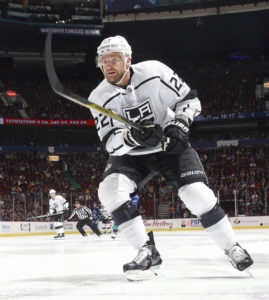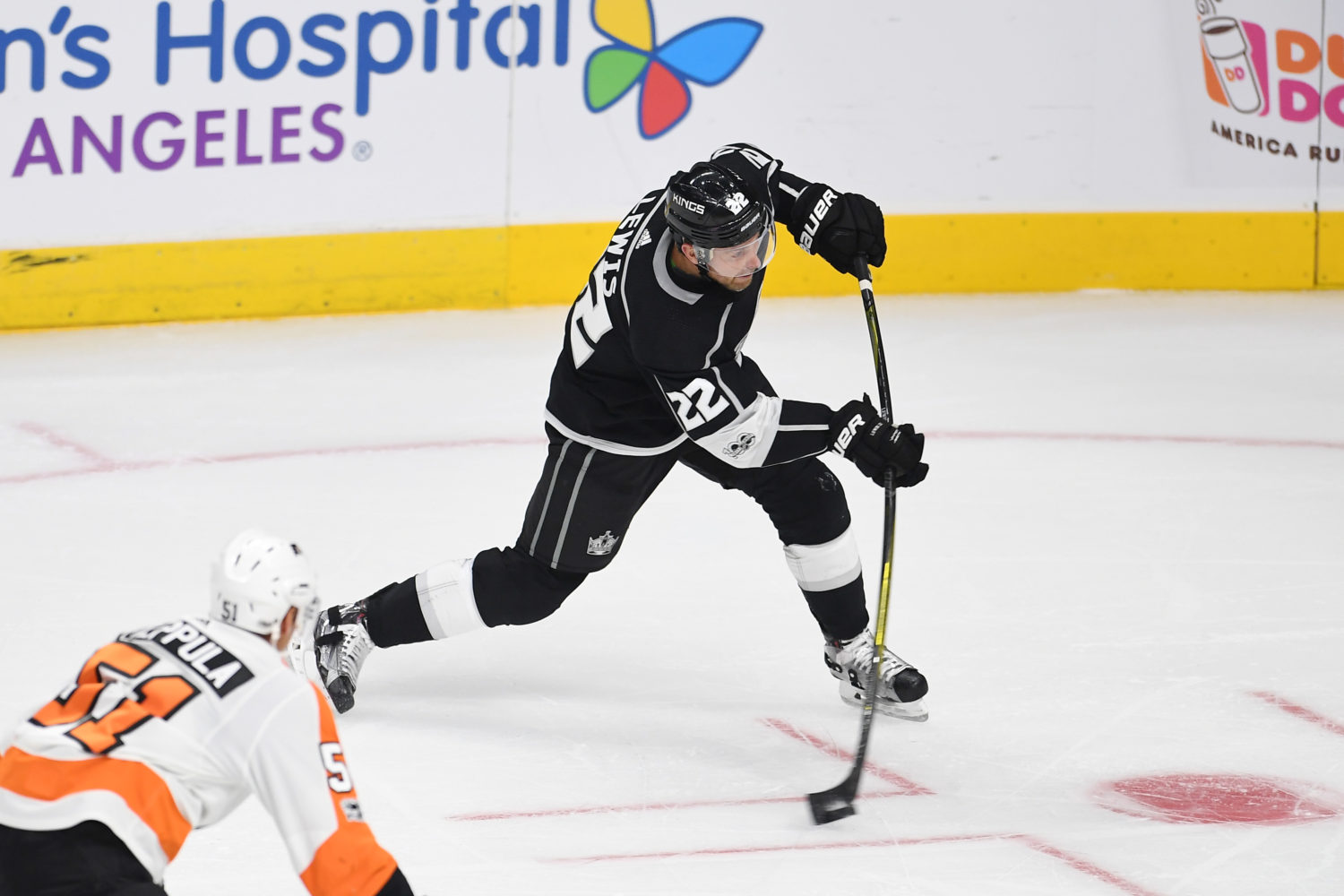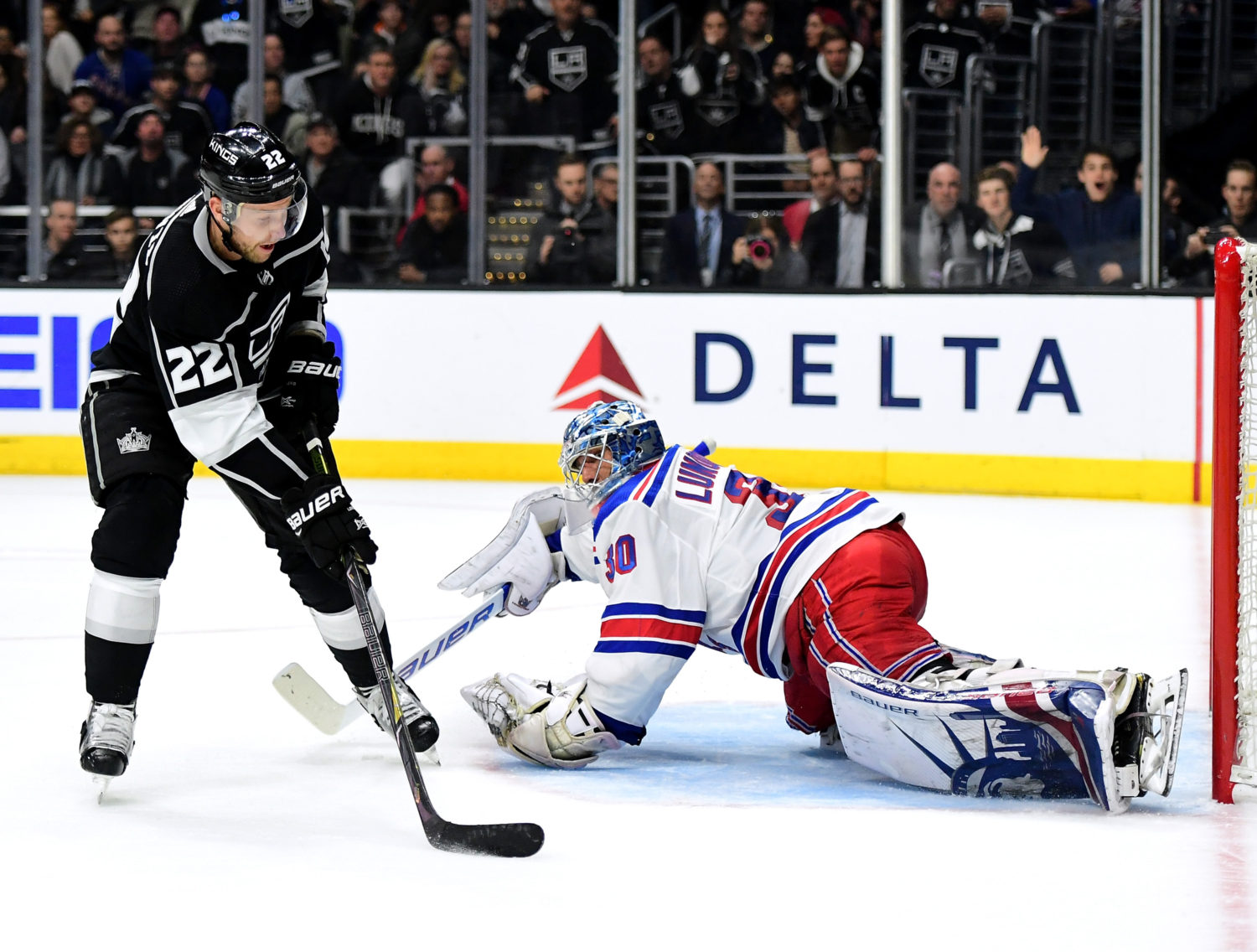This season: 68 games, 14 goals, 12 assists, 26 points, 25 penalty minutes, -6 rating, 134 shots, -0.9% CF%Rel, .986 PDO, 15:14 time on ice
The good: A player you can set a watch to, Trevor Lewis’ consistency, detail, coachability, regimen and approach sets a model for younger players to follow. He’s a valuable, catalyzing veteran member of the team’s leadership core that, after the departure of a high number of character veterans, has naturally evolved to maintain his important and versatile role into one that carries a modest but needed bounty of secondary production. OK, flowery words over. Lewis set career-highs in goals (and shooting percentage) and points in 2017-18 even though the had the lowest offensive zone start percentage out of any qualified player who finished the year with the club. This context is important: Lewis reached career marks personally even though his defensive zone start percentage was the highest, relatively, out of any season in his career. Remarkably, he reached a new career high with his 13th goal in the 52nd game of the season, meaning that he was scoring at a once-every-four-game pace, which placed him right on a 20-goal pace before a pair of upper-body injuries slowed him down over the final third. This followed an off-season discussion between John Stevens and Lewis that indicated the forward would be given a greater opportunity to provide secondary offense for the team. “I’ve always kind of known I could do it (offensively). I think one of my focuses coming up was being a defensive guy and being a guy the coach can rely on to put you out in those key situations,” Lewis said. “I think that helps – playing in a lot more situations obviously helps your confidence. I’m just trying to get to the net more and get those greasy ones, too.”
Lewis scores the occasional greasy goal, but he also began to lightly pad his numbers while on the power play. He logged just over 33 total minutes of power play time but served as a viable option for the second unit whose on-ice 9.00 GF/60 rate in all power play situations ranked fourth among the Kings’ 16 qualified skaters. Lewis had never recorded a power play point over his first five full NHL seasons, and with three this past year, including his second career power play goal, he now has six power play points over the last three seasons. Of course, “power play points” is low on the list of the ways Trevor Lewis’ play is measured. He again contributed a valuable role as Los Angeles’ swiss-army forward who set a career-high in time on ice per game and was a either a first or (primarily) a second choice for John Stevens and Dave Lowry’s top-ranked shorthanded group. Naturally, coaches don’t mind speaking Lewis’ graces. “You always have those glue guys on your team,” Stevens said. “Lewie’s one of those guys, he’s just zero maintenance. You start talking to him about something, and he already knows where you’re going. He understands the game, he really values all the little things in a game. He just does everything right all the time. If you’re teaching your team game and the details of your team game, you can always teach it through Lewie because he just seems to do everything right.” With a shots against-per-60 rate of 27.5, he ranked third among qualified Kings skaters and continued to demonstrate his high-quality shot suppression while defending.
Lewis doesn’t necessarily have the hands or the same finishing ability as several other similarly tenured Cup winners, but he does have both good individual speed and the ability to play with a raised pace and is an effective forechecker who without hesitation goes into the hardest areas around the net and the perimeter to dig pucks loose and win battles. Through his fearless, high-work, low-maintenance ethos, he’s endeared himself both to Kings fans as well as to his teammates, who voted him the club’s Unsung Hero for the seventh consecutive season.
The bad: By virtue of the way he plays, the odd dings and scrapes tend to catch up with him. Credit Lewis for regularly playing through minor injuries and maintenance, but in 2017-18, two separate second half issues derailed what had been the finest 50-plus games of Lewis’ regular season career to that point. During a high-speed race for the puck at Florida on February 9, an off-balance Lewis suffered an upper-body injury and missed 12 games when Jared McCann sent him hard and awkwardly into the corner boards. In his seventh game back after returning from injury, he missed two games because of another upper-body injury that affected him over the final three weeks and four playoff games and necessitated right hand surgery on May 1. (He is expected to recover in time for training camp.) It’s not through any fault of his own – on the contrary, again, these injuries are largely a byproduct of his willingness to battle and thrust himself into the harder areas of the rink – but in part because he wasn’t 100%, he totaled only one assist over his final 17 regular season and playoff games. Despite being a penalty plus-minus stud earlier in his career and the gradual increases in his ice time, the regularity with which he draws penalties has tapered off. Though he had drawn between eight (in 48 games in 2012-13) and 13 penalties during five-on-five play each season between 2010-11 and 2014-15, he drew six for the second consecutive year and was in the red, penalty-wise, for the third consecutive season after remaining on the right side of the ledger every season prior. This isn’t a major deal and is based on his reliance in the defensive zone, where it’s much easier to take penalties. Slightly more of a concern is that Lewis’ 1.63 on-ice GF/60 in five-on-five play placed him below Torey Mitchell, Kevin Gravel and Nick Shore’s rates. He was essentially break-even or negligibly below the water mark shot-wise and chance-wise, and for the third straight year, more 5×5 goals were scored against the Kings with Lewis on the ice than goals for.
Going forward: Lewis is paid commensurate to his one-size-fits-all role and has two seasons remaining on his contract at $2M per season. It’s not hard to imagine a 2018-19 campaign in which he deposits another 26 or 27 points into the Kings’ scoring bank, largely in line with his remarkably consistent play and production. It’s probably too much to expect him to maintain a 20-goal pace over 82 games, but will this finally be the season he breaks 30 points? Should he log upwards of 75 games, it’s certainly a reachable target given Lewis’ ability to use checking to create his offense and how Stevens and his staff will look to wring production out of the team’s secondary group. As the aforementioned Glue Guy, Lewis is among the easier players to forecast. “Lewy is just a guy who you love everything he does,” Stevens said.
Lewis evaluations: 2017 | 2016 | 2015 | 2014 | 2013 | 2012 | 2011 | 2010 | 2009
Player evaluations: #3 DION PHANEUF | #5 CHRISTIAN FOLIN | #6 JAKE MUZZIN | #7 OSCAR FANTENBERG | #8 DREW DOUGHTY | #9 ADRIAN KEMPE | #10 TOBY RIEDER | #11 ANZE KOPITAR | #13 KYLE CLIFFORD | #15 ANDY ANDREOFF | #19 ALEX IAFALLO | #22 TREVOR LEWIS | #23 DUSTIN BROWN | #24 DEREK FORBORT | #27 ALEC MARTINEZ | #32 JONATHAN QUICK | #44 NATE THOMPSON | #52 MICHAEL AMADIO | #70 TANNER PEARSON | #71 TORREY MITCHELL | #73 TYLER TOFFOLI | #77 JEFF CARTER | KUEMPER / CAMPBELL | THE OTHERS
-Advanced stats via Corsica, Natural Stat Trick
-Lead photo via Aaron Poole/NHLI






Rules for Blog Commenting
Repeated violations of the blog rules will result in site bans, commensurate with the nature and number of offenses.
Please flag any comments that violate the site rules for moderation. For immediate problems regarding problematic posts, please email zdooley@lakings.com.